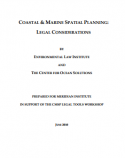
Research Reports
ELI publishes Research Reports available for free download that present the analysis and conclusions of the policy studies ELI undertakes to improve environmental law and policy. These reports contribute to education of the profession and disseminate diverse points of view and opinions to stimulate a robust and creative exchange of ideas. Those publications, which express opinions of the authors and not necessarily those of the Institute, its Board of Directors, or funding organizations, exemplify ELI’s commitment to dialogue with all sectors.
Status and Trends in State Invasive Species Policy: 2002-2009 reviews developments in state laws and regulations governing invasive species in eleven states. It finds that invasive species laws and regulations are often fragmented and incomplete and have developed primarily on a species-by-species basis in response to crisis. As a result, they often fail to address potential future invaders or close off known invasion pathways.
Read More >
This report provides a comparative study of how a number of nations share or distribute responsibility for governing with respect to environmental issues, and more specifically pollution control and prevention. The principal nations studied include Brazil, China, Mexico, and the United States, while information on selected aspects of environmental governance is provided for Australia, Canada, Germany, and Switzerland.
Read More >
The Environmental Law Institute (ELI) and the University of North Carolina Institute for the Environment (IE) have released a report identifying opportunities to coordinate habitat conservation and hazard mitigation planning in areas at risk of flooding and other natural hazards.
Read More >
This report offers model language that could be incorporated into in-lieu fee program instruments being developed by state agencies and non-profit organizations. It was designed to comply with the 2008 Compensatory Mitigation Rule. It was developed using the best available information and uses examples from the approved and draft in-lieu fee instruments that were available as of December 2009. Funding for this project was made possible thanks to a grant provided by the U.S. Environmental Protection Agency.
Read More >